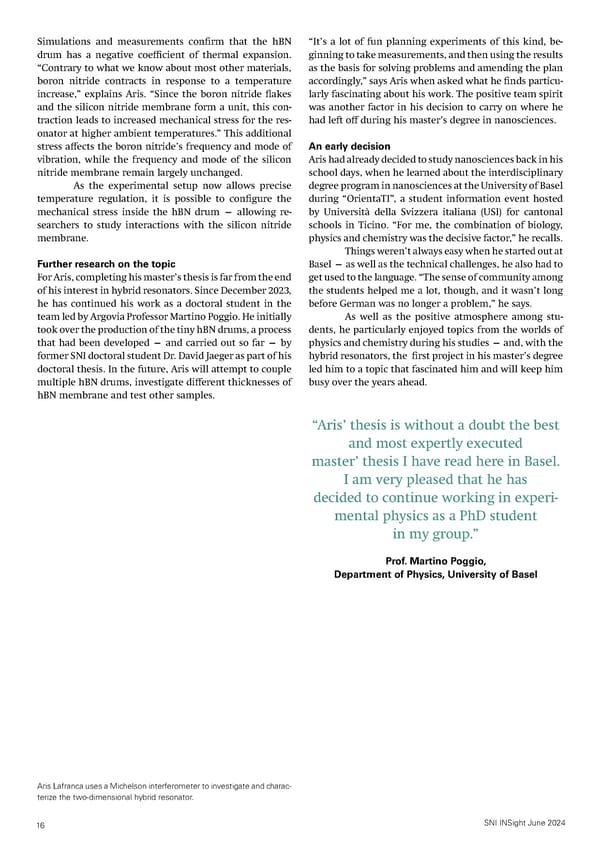Master's project at University of Cambridge
Michelle Arnet did her master's thesis in nanoscience at the University of Cambridge and reports about the unique experience.
Simulations and measurements con昀椀rm that the hBN “It’s a lot of fun planning experiments of this kind, be- drum has a negative coe昀케cient of thermal expansion. ginning to take measurements, and then using the results “Contrary to what we know about most other materials, as the basis for solving problems and amending the plan boron nitride contracts in response to a temperature accordingly,” says Aris when asked what he 昀椀nds particu- increase,” explains Aris. “Since the boron nitride 昀氀akes larly fascinating about his work. The positive team spirit and the silicon nitride membrane form a unit, this con- was another factor in his decision to carry on where he traction leads to increased mechanical stress for the res- had left o昀昀 during his master’s degree in nanosciences. onator at higher ambient temperatures.” This additional stress a昀昀ects the boron nitride’s frequency and mode of An early decision vibration, while the frequency and mode of the silicon Aris had already decided to study nanosciences back in his nitride membrane remain largely unchanged. school days, when he learned about the interdisciplinary As the experimental setup now allows precise degree program in nanosciences at the University of Basel temperature regulation, it is possible to con昀椀gure the during “OrientaTI”, a student information event hosted mechanical stress inside the hBN drum — allowing re- by Università della Svizzera italiana (USI) for cantonal searchers to study interactions with the silicon nitride schools in Ticino. “For me, the combination of biology, membrane. physics and chemistry was the decisive factor,” he recalls. Things weren’t always easy when he started out at Further research on the topic Basel — as well as the technical challenges, he also had to For Aris, completing his master’s thesis is far from the end get used to the language. “The sense of community among of his interest in hybrid resonators. Since December 2023, the students helped me a lot, though, and it wasn’t long he has continued his work as a doctoral student in the before German was no longer a problem,” he says. team led by Argovia Professor Martino Poggio. He initially As well as the positive atmosphere among stu- took over the production of the tiny hBN drums, a process dents, he particularly enjoyed topics from the worlds of that had been developed — and carried out so far — by physics and chemistry during his studies — and, with the former SNI doctoral student Dr. David Jaeger as part of his hybrid resonators, the 昀椀rst project in his master’s degree doctoral thesis. In the future, Aris will attempt to couple led him to a topic that fascinated him and will keep him multiple hBN drums, investigate di昀昀erent thicknesses of busy over the years ahead. hBN membrane and test other samples. “Aris’ thesis is without a doubt the best and most expertly executed master’ thesis I have read here in Basel. I am very pleased that he has decided to continue working in experi- mental physics as a PhD student in my group.” Prof. Martino Poggio, Department of Physics, University of Basel Aris Lafranca uses a Michelson interferometer to investigate and charac- terize the two-dimensional hybrid resonator. SNI INSight June 2024 16
 SNI INSight June 2024 Page 15 Page 17
SNI INSight June 2024 Page 15 Page 17